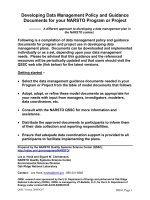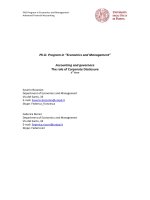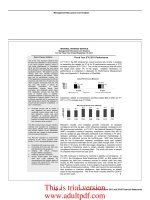Management Accounting and Decision-Making doc
Bạn đang xem bản rút gọn của tài liệu. Xem và tải ngay bản đầy đủ của tài liệu tại đây (510.67 KB, 16 trang )
Management Accounting | 15
Management Accounting and Decision-Making
Management accounting writers tend to present management accounting as a
loosely connected set of decision‑making tools. Although the various textbooks on
management accounting make no attempt to develop an integrated theory, there is
a high degree of consistency and standardization in methodology of presentation.
In this chapter, the concepts and assumptions which form the basis of management
accounting will be formulated in a comprehensive management accounting decision
model.
The formulation of theory in terms of conceptual models is a common practice.
Virtually all textbooks in business administration use some type of conceptual
framework or model to integrate the fundamentals being presented. In economic
theory, there are conceptual models of the rm, markets, and the economy. In
management courses, there are models of organizational structure and managerial
functions. In marketing, there are models of marketing decision‑making and channels
of distribution. Even in nancial accounting, models of nancial statements are used
as a framework for teaching the fundamentals of basic nancial accounting. The
model, A = L + C, is very effective in conveying an understanding of accounting.
Management accounting texts are based on a very specic model of the business
enterprise. For example, all texts assume that the business which is likely to use
management accounting is a manufacturing business. Also, there is unanimity in
assuming that the behavior of variable costs within a relevant range tends to be
linear. The consequence of assuming that variable costs vary directly with volume
is a classication of cost into xed and variable. A description of the managerial
accounting perspective of management and the business enterprise will help put in
focus the subject matter to be presented in later chapters.
16 | CHAPTER TWO • Management Accounting and Decision-Making
The Management Accounting Perspective of the Business Enterprise
The management accounting view of business may be divided into two broad
categories: (1) basic features and (2) basic assumptions.
Basic Features
The business rm or enterprise is an organizational structure in which the basic
activities are departmentalized as line and staff. There are three primary line functions:
marketing, production, and nance. The organization is run or controlled by individuals
collectively called management. The staff or advisory functions include accounting,
personnel, and purchasing and receiving. The organization has a communication or
reporting system (e.g. budgeting) to coordinate the interaction of the various staff
and line departmental functions. The environment in which the organization operates
includes investors, suppliers, governments (state and federal), bankers, accountants,
lawyers, competitors, etc.)
The organizational aspect of the business rm is illustrated in Figure 2.1. This
descriptive model shows that there are different levels of management. A commonly
used approach is to classify management into three levels: Top management, middle
management, and lower level management. The signicance of a hierarchy of
management is that decision‑making occurs at three levels.
Basic Assumptions in Management Accounting
The framework of management accounting is based on a number of implied
assumptions. Although no single work has attempted to identify all of the assumptions,
Board of
Directors
President
Vice-President
Production
Manager
Finishing Dept.
Manager
Cutting Dept
Manager
Finishing Dept.
Vice-President
Finance
Vice-President
Marketing
Accounting
Department
Income
Statement
Balance Sheet
Figure 2.1 • Conventional Organizational Chart
Management Accounting | 17
the major assumptions will be detailed below. Five categories of assumptions will be
presented:
1. Basic goals
2. Role of management
3. Nature of Decision‑making
4. Role of the accounting department
5. Nature of accounting information
Basic Goal Assumptions -
The basic goals or objectives the business enterprise
may be multiple. For example, the goal may be to maximize net income. Other goals
could be to maximize sales, ROI, or earnings per share. Management accounting
does not require a specic of type of goal. However, whatever form the goal takes,
management will at all times try to achieve a satisfactory level of prot. A less than
satisfactory level of prot may portend a change in management.
Role of Management Assumptions -
The success of the business depends
primarily upon the skill and abilities of management–which skills can vary widely
among different managers. The business is not completely at the mercy of market
forces. Management can through its actions (decisions) inuence and control events
within limits. In order to achieve desired results, management makes use of specic
planning and control concepts and techniques. Planning and control techniques
which management may use include business budgeting, cost‑volume‑prot
analysis, incremental analysis, exible budgeting, segmental contribution reporting,
inventory models, and capital budgeting models. Management, in order to improve
decision‑making and operating results, will evaluate performance through the use of
exible budgets and variance analysis.
Decision-making Assumptions - A critical managerial function is decision‑
making. Decisions which management must make may be classied as marketing,
production, and nancial. Decisions may also be classied as strategic and tactical
and long‑run and short‑run. A primary objective of decision‑making is to achieve
optimum utilization of the business’s capital or resources. Effective decision‑making
requires relevant information and special analysis of data.
Accounting Department Assumptions - The accounting department is a primary
source of information necessary in making‑decisions. The accounting department
is expected to provide information to all levels of management. Management will
consider the accounting department capable of providing data useful in making
marketing, production, and nancial decisions.
Nature of Accounting Information - In order for the accounting department to
make meaningful analysis of data, it is necessary to distinguish between xed and
variable costs and other types of costs that are not important in the recording of
business transactions. Some but not all of the information needed by management can
be provided from nancial statements and historical accounting records. In addition to
historical data, management will expect the management accountant to provide other
types of data, such as estimates, forecasts, future data, and standards. Each specic
18 | CHAPTER TWO • Management Accounting and Decision-Making
managerial technique requires an identiable type of information. The accounting
department will be expected to provide the information required by a specic tool. In
order for the accounting department to make many types of analysis, a separation of
costs into xed and variable will be required. The management accountant need not
provide information beyond the relevant range of activity.
Implications of the Basic Assumptions
The assumption that there are three types of decisions,( marketing, production,
and nancial) requires that management identify the specic decisions under each
category. The identication of specic decisions is critical because only then can the
appropriate managerial accounting technique be properly used.
Some typical management decisions of a manufacturing business include:
Marketing Production Financial
Pricing Units of equipment Issue of bonds
Sales forecast Factory workers’ wages Issue of stock
Number of sales people Overtime, second shift Bank loan
Sales people compensation Replacement of equipment Retirement of bonds
Number of products Inventory levels Dividends
Advertising Order size Investment in securities
Credit Suppliers
An understanding of nancial statements is critical to the ability of management
to make good decisions. Financial statements, although prepared by accountants,
are actually created by management through the implementation of decisions. The
historical data from which accountants prepare nancial statements result from actual
management decisions. The reader and user of nancial statements is not primarily
the accountant but management. From a management accounting point of view, it is
management rather than accountants that needs to have the greater understanding
of nancial statements.
The income statement and the balance sheet can be viewed as a descriptive
model for decision‑making. Financial statements reect success or lack of success
in making decisions. Management can be deemed successful when the desired
income has been attained and nancial position is considered sound. To achieve
managerial success management must manage successfully the assets, liabilities,
capital, revenue and expenses. Financial statements, then, serve as a ready and
convenient check list of decision‑making areas.
The basic balance sheet equation, of course, is A = L + C. A management
accounting interpretation is that the assets or resources come from the creditors
(liabilities) and the owners (capital). It is management responsibilities to manage
both sides of the equation. That is, management must make decisions about both the
resources (assets) and the sources of the assets (liabilities and capital).
Each item on the balance sheet is an area of management. Stated differently each
item on nancial statements represents a critical area sensitive to mismanagement.
Management Accounting | 19
Cash, accounts receivable, inventory, xed assets, accounts payable, etc. can be too
large or too small. Given this fact, then, for each item there must be the right amount
or optimum. It is management’s responsibility to make the best decision possible
regarding each item on the nancial statements. Gross mismanagement of any single
item could either result in the failure of the business or the downfall of management.
Following are some examples of decisions associated with specic nancial
statement items:
Balance Sheet Items Decision
Cash Minimum level
Accounts receivable Credit terms
Inventory Order size
Fixed asset Capacity size
Bonds payable Amount and interest rate
Income Statement Items
Sales Price, number of products, number
of sales people
Salesmen compensation Salaries and commission rate
Advertising Media, advertising budget
The statement that the management accountant will be required to furnish
information not of a historical nature means that the accountant will have to deal
with planned and estimated or future data. Furthermore, much of this data will be
not be found in the historical data bank from which the accountant prepares nancial
statements. The management accountant may be required to do analysis requiring
data of an economic nature. For example, analysis of pricing may require data
about the company’s demand curve. Labor cost analysis may require estimating the
productivity of labor relative to various wage rates.
Decision-making in Management Accounting
In management accounting, decision‑making may be simply dened as choosing
a course of action from among alternatives. If there are no alternatives, then no
decision is required. A basis assumption is that the best decision is the one that
involves the most revenue or the least amount of cost. The task of management with
the help of the management accountant is to nd the best alternative.
The process of making decisions is generally considered to involve the following
steps:
1 Identify the various alternatives for a given type of decision.
2. Obtain the necessary data necessary to evaluate the various alternatives.
3. Analyze and determine the consequences of each alternative.
4. Select the alternative that appears to best achieve the desired goals or
objectives.
5. Implement the chosen alternative.
6. At an appropriate time, evaluate the results of the decisions against
standards or other desired results.
20 | CHAPTER TWO • Management Accounting and Decision-Making
From the descriptive model of the basic features and assumptions of the
management accounting perspective of business, it is easy to recognize that
decision‑making is the focal point of management accounting. The concept of
decision‑making is a complex subject with a vast amount of management literature
behind it. How businessmen make decisions has been intensively studied. In
management accounting, it is useful to classify decisions as:
1. Strategic and tactical
2. Short‑run and long‑run
Strategic and Tactical Decisions
In management accounting, the objective is not necessarily to make the best
decision but to make a good decision. Because of complex interacting relationships,
it is very difcult, even if possible, to determine the best decision. Management
decision‑making is highly subjective.
Whether a decision is good or acceptable depends on the goals and objectives of
management. Consequently, a prerequisite to decision‑making is that management
have set the organization’s goals and objectives. For example, management must
decide strategic objectives such as the company’s product line, pricing strategy,
quality of product, willingness to assume risk, and prot objective.
In setting goals and objectives, it is useful to distinguish between strategic and
tactical decisions. Strategic decisions are broad‑based, qualitative type of decisions
which include or reect goals and objectives. Strategic decisions are non quantitative
in nature. Strategic decisions are based on the subjective thinking of management
concerning goals and objectives.
Tactical decisions are quantitative executable decisions which result directly from
the strategic decisions. The distinction between strategic and tactical is important in
management accounting because the techniques of management accounting pertain
primarily to tactical decisions. Management accounting does not typically provide
techniques for assisting in making strategic decisions.
Examples of strategic decisions and tactical decisions from a management
accounting point of view include:
Decision items Strategic Decisions Tactical Decisions
Cash Maintain minimum level
without excessive risk Specic level of cash
Accounts receivable Sell on credit Specic credit terms
Inventory Maintain safety stock Specic level of inventory
Price Be volume dealer by Specic price
setting price lower than
competition
Once a strategic decision has been made, then a specic management tool can be
used to aid in making the tactical decision. For example, if the strategic decision has
been made to avoid stock outs, then a safety stock model may be used to determine
the desired level of inventory.
Management Accounting | 21
The classication of decisions as strategic and tactical logically results in thinking
about decisions as qualitative and quantitative. In management accounting, the
approach to decision‑making is basically quantitative. Management accounting deals
with those decisions that require quantitative data. In a technical sense, management
accounting consists of mathematical techniques or decision models that assist
management in making quantitative type decisions.
Examples of quantitative decisions include:
Decision Quantitative Criterion
Price Maximum income
Inventory order size Minimum total inventory cost
Purchase of new equipment Lowest operating costs
Credit terms Maximum net income/sales
Sales people compensation Minimum total compensation
Short‑run Versus Long-run Decision-making
The decision‑making process is complicated somewhat by the fact that the horizon
for making decisions may be for the short‑run or long‑run. The choice between the
short‑run or the long‑run is particularly critical concerning the setting of protability
objectives. A fact of the real business world is that not all companies pursue the same
measures of success. Protability objectives which management might choose to
maximize include:
1. Net income
2. Sales
3. Return on total assets
4. Return on total equity
5. Earnings per share
The decision‑making process is, consequently, affected by the protability
objective and the choice of the long‑run versus the short‑run. If the objective is to
maximize sales, then the method of nancing a new plant is not immediately important.
However, if the objective is to maximize short‑run net income, then management might
decide to issue stock rather than bonds to avoid interest expense. In the short‑run,
prots might suffer from expenditures for preventive maintenance or research and
development. In the long run, the company’s prot might be greater because of
preventive maintenance or research and development.
Although the interests of management and the organization may be presumed
to coincide, the possibility of making decisions for the short‑run may cause a conict
in interests. An individual manager planning to make a career or job change might
have a tendency to make decisions that maximize protability in the short‑run. The
motivation for pursuing short‑run prots may be to create a favorable resume.
The tools in management accounting such as C‑V‑P analysis, variance analysis,
budgeting, and incremental analysis are not designed to deal with long range
objectives and decision. The only tools that looks forward to more than one year
22 | CHAPTER TWO • Management Accounting and Decision-Making
are the capital budgeting models discussed in chapter 12. Consequently, the results
obtained from using management accounting tools should be interpreted as benets
for the short‑run, and not necessarily the long‑run. Hopefully, decisions which clearly
benet the short‑run will also benet the long‑run. Nevertheless, it is important for the
management accountant, as well as management, to beware of possible conicts
between short‑run and long‑run planning and decision‑making.
Management Accounting Decision Models
Management accounting consists of a set of tools that have been proven to be
useful in making decisions involving revenue and cost data. Even though many of
the techniques appear to be simplistic in nature, they have proven to be of consider‑
able value. A comprehensive list of the tools and their mathematical nature which
constitute management accounting appears in Appendix C of this book.
The techniques which are also listed in Figure 2.2 are all based on mathematical
equations or mathematical relationships. All of the techniques may be regarded
as mathematical decision‑making models. For example, the foundation of C‑V‑P
analysis is the equation: I = P(Q) - V(Q) - F. The mathematical models which form the
foundation of every tool are summarized in Appendix C to this book.
The approach described above concerning the use of nancial statements as a
check list to identify decision‑making areas may also be used to identify the appropriate
management accounting technique. For every item on nancial statements, there is
one or more appropriate management accounting technique.
The following illustrates the association of management accounting tools with
specic nancial statement items.
Financial Statement Items Management Accounting Tools
Balance Sheet:
Cash Cash budget
Capital budgeting models
Accounts receivable Incremental analysis
Inventory EOQ models, Safety stock model
Fixed assets Incremental Analysis, Capital budgeting
Income Statement:
Sales C‑V‑P analysis, Segmental reporting
Incremental analysis
Expenses C‑V‑P analysis, Incremental analysis
Net income Direct costing
Management Accounting | 23
Figure 2.2 • Management Accounting Tools
1. Comprehensive business budgeting
2. Flexible budgeting and variance analysis
3. Variance analysis
4. Capital budgeting
5. Incremental analysis
Keep or replace
Additional volume of business
Credit analysis
Demand analysis
Sales people compensation analysis
Capacity analysis
6. Cost‑volume‑prot analysis
7. Cost behavior analysis
8. Return on investment analysis
9. Economic order quantity analysis
10. Safety stock/lead time analysis
11. Segmental reporting analysis
Decision-making and Required Information
The assumption that management will use management accounting tools in
making decisions places a burden on the management accountant. Each tool
requires special information. The management accountant will be asked to provide
the specialized information needed. Management accounting texts have traditionally
emphasized the mechanics of techniques with little emphasis on how to obtain the
necessary data. In many cases, the inability to obtain the required information has
rendered a particular technique useless.
The following illustrates the kind of information required for certain selected
tools:
Tools Required Information
Flexible budget Variable cost rates
Variance analysis Standard costs
EOQ models Purchasing cost, carrying cost
Incremental analysis Opportunity cost, escapable costs
Capital budgeting models Future cash inows, future cash
outows
Cost‑volume‑prot analysis Variable cost percentage, xed cost,
desired income
24 | CHAPTER TWO • Management Accounting and Decision-Making
Comprehensive Management Accounting Decision Model
As the above discussion should make clear, decision‑making is a complex network
of interrelated decision variables. Management can face an overwhelming task if it tries
to identify every variable and minute decision relationship. One approach to dealing
with complexity is the development of models, both mathematical and descriptive for
the purpose of simulating only the relevant or more important variables. Management
accounting is, therefore, one approach to simplifying complex relationships by dealing
with key variables and models based on restricting assumptions.
The decision‑making process discussed in this chapter leads to the conclusion
from a management accounting perspective that there is a connecting link between
the following:
1. Financial statement items
2. Strategic and tactical decisions
3. Management accounting techniques
4. Decision‑making information
The relationships among these elements may be summarized by the following
diagram:
Financial
Statement Items
Strategic
Decisions
Tactical
Decisions
Tools
Management
Accounting
Information
These relationship as discussed may be used to develop a comprehensive
management accounting decision model for a manufacturing business. The complete
version of this model as it applies to a manufacturing rm from a management
accounting viewpoint is illustrated in the appendix to this chapter as Exhibits I, II, and
III.
Summary
From a management accounting point of view the primary purpose of management
is to make decisions that may be classied as marketing, production, and nancial.
The tactical decisions which must be preceded by strategic decisions provide the
historical data from which the accountant prepares nancial statements. In addition
to being statements summarizing historical transactions, nancial statements may be
regarded as a descriptive model for decision‑making. Every item or element on the
nancial statements is the result of a decision or decisions. For each decision, there
exists a management accounting tool that may be used to make a good decision.
However, the management accounting tools can be used only if the management
accountant is successful in providing the information demanded by the particular
tool.
Management Accounting | 25
Appendix: Management Accounting Decision‑Making Model
Exhibit 1 Balance Sheet Model
Strategic
Decisions
Tactical
Decisions
Management
Accounting Tool
Required
Information
Assets
Cash Risk Minimum
balance
Amount needed
Cash budget Cash inows
Cash outows
Accounts
receivable
Credit Credit terms Incremental analysis Additional sales
Additional ex‑
penses
Inventory
Materials
Finished Goods
Risk
Quality
Risk
Order size, no. of
orders
Supplier
Safety stock
EOQ model
Safety models
Purchasing cost
Carrying cost
Demand
Probability
distributions
Fixed Assets Capacity
Purchase/
lease
Depreciation
methods
Rate of return
Capital budgeting Cash inows/out‑
ows
Present value
tables
Investments Risk/
diversication
Number of
shares
Capital budgeting Potential dividends
/ earnings
Liabilities
Accounts pay‑
able
Leverage Amount to pay/
not pay
Cost analysis Interest rate
Terms of credit
Notes payable
Leverage
Short‑term vs.
long‑term
Amount borrow/
repay
Interest rate/
lender
ROI analysis
Incremental analysis
Interest rate
Cost of capital
Bonds payable Leverage
Short‑term
versus
long‑term
Shares to issue
Shares to retire
ROI analysis
Incremental analysis
Cost of capital
analysis
Interest rate
Cost of capital
ROI data
Stockholders’
Equity
Common stock Leverage / risk Shares to issue
Amount needed
ROI analysis
Incremental analysis
Cost of capital
analysis
Cost of capital
Cost of issuing
ROI data
Retained
earnings
Internal
nancing
Risk
Amount of
dividend
Type of dividend
Incremental analysis
Cost of capital
analysis
ROI data
Cost of capital
26 | CHAPTER TWO • Management Accounting and Decision-Making
Exhibit 2 • Income Statement Model
Strategic
Decisions
Tactical
Decisions
Management
Accounting
Tool
Required
Information
Sales Market share
Growth
Price
Number of
territories
Credit
Additional
volume
Incremental
analysis
C‑V‑P analysis
Cost behavior
Demand curve
Fixed & variable
costs
Cost of goods sold
Beginning inventory
Cost of goods mfd.
Ending inventory
(See exhibit 3)
Risk
Amount of
safety stock
EOQ model
Safety stock
model
Probability of
stock out
Purchasing costs
Carrying costs
Gross prot
Expenses
Selling
Sales people salaries
Commissions
Sales people training
Travel
Advertising
Packaging
Bad debts
Sales ofce rentals
Ofce operating
Home ofce
Motivation/turnover
Motivation/turnover
Risk/volume
Risk
Salary
Number of
sales people
Commission
rate
Number of new
people
Amount of
advertising
Bad debt
estimate
Incremental
analysis
C‑V‑P analysis
Price of product
Calls per month
Fixed and vari‑
able costs
Sales forecast
Market potential
Bad debt prob‑
ability
General and Admin.
Executive salaries
Secretaries
Supplies
Depreciation
Travel
Effective service
Turnover
Amounts of
salaries
C‑V‑P analysis Fixed and vari‑
able costs
Net income
Management Accounting | 27
Exhibit 3 • Cost of Goods Manufactured Model
Strategic
Decisions
Tactical
Decisions
Management
Accounting Tool
Required
Information
Materials Used
Materials (BI) Safety stock model Lead time
Demand
Material
Purchases
Quality
Standards
Budgeted pro‑
duction
Suppliers
Order size
Number of orders
Sales forecast
Budgeted production
Incremental analysis
EOQ model
Carrying cost
Purchasing cost
Demand
Freight-in Suppliers Incremental analysis Quantity discount
schedule
List prices
Direct labor Productivity
Motivation
Capacity
Industry repu‑
tation
Wage rate
Number of
workers
Second shift/
overtime
New equipment
Incremental analysis
Business budgeting
C‑V‑P analysis
Fixed and variable
costs
Relevant costs
Wage rates
Productivity rates
Variable
manufacturing
overhead
Capacity Keep or replace
Wage rates
Incremental analysis Variable cost rates
Cost factors
Physical factors
Fixed Manufacturing Overhead
Fixed direct labor Capacity Keep or replace Incremental analysis
C‑V‑P analysis
Fixed and variable
product cost
Utilities Capacity Keep or replace Incremental analysis Fixed and variable
product cost
Production
planning
Capacity Incremental analysis Fixed and variable
product cost
Purchasing &
receiving
Capacity Incremental analysis Fixed and variable
product cost
Factory
insurance
Capacity Incremental analysis Fixed and variable
product cost
Depreciation,
equipment
Capacity Keep or replace Incremental analysis Fixed and variable
product cost
Deprecation,
building
Capacity Incremental analysis Fixed and variable
product cost
Factory supplies Capacity Incremental analysis Fixed and variable
product cost
28 | CHAPTER TWO • Management Accounting and Decision-Making
Q. 2.1 List four examples of strategic decisions.
Q. 2.2 List six examples of tactical decisions.
Q. 2.3 What type of nancial goals may management set for the business?
Q. 2.4 What is the primary role of management in a business from a
management accounting point of view?
Q. 2.5 In what different ways may decisions be classied?
Q. 2.6 What kinds of information can the management accountant be expected
to provide to management?
Q. 2.7 Explain how nancial statements can be used to identify the decisions
that management is required to make.
Q. 2.8 Management accounting consists of a set of tools. For each of the
following tools list the basic information required.
1. Business Budgeting
2. Cost‑volume‑prot analysis
3. Flexible budgeting
4. Return on investment analysis
5. Segmental contribution income statements
6. Economic order quantity model
7. Incremental analysis
Management Accounting | 29
Exercise: 2.1 • Strategic and Tactical Decisions
For each item listed below, indicate (4) whether that decision is primarily strategic
in nature or primarily tactical in nature.
Classifying Management Decisions
Strategic Decision Tactical Decision
1 Management has decided to sell on credit.
2 Management has decided to keep the cash balance as
low as possible.
3 Management has set a minimum balance of $100,000
for the cash account.
4 Management has decided to keep the turnover ratio of
management as low as possible.
5 Management has decided for this quarter that an
inventory turnover ratio of 12 is desirable.
6 Management has decided to determine the correct
order size by use of an EOQ model.
7 Management for the current quarter set the safety
stock of raw materials at 1,000 units.
8 Management has decided to use internal nancing as
a means of expending the business.
9 Management has decided to issue $10,000,000 in 10
year bonds.
10 Management has decided it wants to be a high volume
seller by setting price to be the lowest in the industry.
11 Management for the current quarter set price at $300.
12 Management has decided to compensate sales people
with an above industry average commission rate.
13 Management for the current quarter set the sales
people commission rate at 10%.
14 Management has decided to motivate factory workers
with a wage rate that is above the industry average.
15 Management has decided that the current quarter
wage rate should be $15 per hour.
30 | CHAPTER TWO • Management Accounting and Decision-Making
Exercise 2.2
In the left hand column is a list of decisions. In the right hand column is a list of
different types of information. For each decision in the left hand column, identify from
the right hand column the type of information that would be helpful in making that
decision.
Decision-making Information
Decision Helpful information Types of Information
1. Increase in price A. Fixed expenses
2. Increase in advertising B. Variable cost rates
3. Increase in material order size C. Demand curve
4. Purchase of new plant and
equipment
D. Carrying cost of materials
5. Addition of a new territory E. Purchasing cost of materials
6. Closing of a territory F. Maximum capacity required
7. Increase in credit terms G. Calls per month‑sales people
8. Replacement of old equipment H. Escapable expenses
9. Increase in sales people
commission rate
I. Inescapable expenses
10. Issue of bonds J. Cost of capital
K. Direct costs
L. Indirect costs
M. Price of product
N. Quantity discount schedule
O. Cost of equipment‑ different
suppliers









